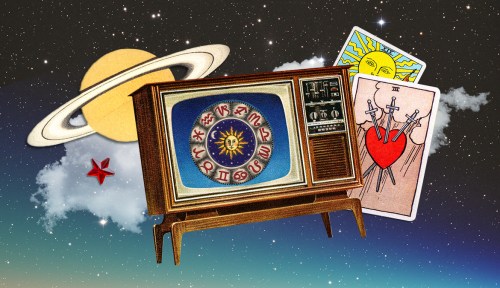Our editors independently select these products. Making a purchase through our links may earn Well+Good a commission
While the history of women and pleasure is fraught with stigma, it appears we’re in the midst of a pleasure revolution. Now, female-identifying founders are creating pornography, sex toys, sex-education platforms, and erotica, all of which normalizes and celebrates a woman’s right to get off. Not only are consumers turned on by this building movement—the global sex toy market alone is expected to be worth $35 billion by 2023, up from $23.7 billion in 2017—but investors, too, are shuttling millions of dollars into sexual wellness start-ups such as Dipsea, a sexy short-story app, and Unbound, an e-tailer selling sex toys and other bedroom accessories. In short, there’s never been a better time than now for having a vulva and loving to orgasm.
So how did we get to this place of openness when, just two decades ago, Samantha Jones’ unapologetic pursuit of big Os on Sex and the City was considered radical? While there have been many twists and turns throughout the history of women and pleasure, it can be argued that the modern movement’s roots first planted in the 1950s. Back then, attitudes toward sexuality were still, in many ways, informed by the repressive Victorian era—when society demanded a “don’t ask, don’t tell” attitude toward female desire. Yet in 1953, sexologist and biologist Alfred C. Kinsey, PhD, published his landmark (and controversial) book titled Sexual Behavior in the Human Female, which shed light on women’s then-rarely discussed habits regarding masturbation, orgasms, and sex before marriage. (Spoiler alert: Among the 6,000 women interviewed for the book, all of those activities were highly popular.) From there, the world slowly but surely opened its eyes to women as sexual beings.
The early history of women and pleasure
Four years following the release of Dr. Kinsey’s book, William Masters and Virginia Johnson began their pioneering work on the physical mechanisms behind sexual arousal at Washington University in St. Louis. Their most groundbreaking findings are still frequently cited today, like the four stages of sexual arousal—excitement, plateau, orgasm, and resolution—and the idea that women are able to have multiple orgasms. “Even the very suggestion that sexual pleasure might be important for women and not just men was massively radical during those times,” says Zhana Vrangalova, PhD, professor of human sexuality at New York University and resident sexpert for sex-toy brand Lelo.
As the history of women and pleasure progressed, a succession of cultural milestones continued to help champion the idea of non-procreative sex among women. First, the birth control pill hit the market in 1960, which officially allowed women to have sex without the prospect of pregnancy. Helen Gurley Brown’s book Sex and the Single Girl (1962) gave advice for sex and dating as an unmarried woman, and a group of Boston women later self-published the seminal Our Bodies, Ourselves (1970), which provided evidence-based information to teach women about their sexual anatomy. Then as the hippie counterculture spread a message of free love, leaders of the second-wave feminist movement encouraged women to take an active role in their own sexual experience. You know, like men had been doing for centuries beforehand.
Despite all of this progress, however, Dr. Vrangalova points out that the framework for female pleasure in the 1960s and early ’70s was still largely based on a male perspective. “Given that the ’60s were a time when women were still very much second-class citizens, the way sexual pleasure was conceptualized was the way men, rather than women, thought about pleasure,” she says. “There’s no doubt women participated, but it seems like they adopted the male-driven vision of sexual pleasure, rather than focusing specifically on female pleasure. This was an inevitable product of the times—even scientists across diverse fields believed that whatever findings were true of men were also true of women, more or less.” For instance, at this point in the history of women and pleasure, there was still a pervasive view that women, like men, should be able to reach orgasm through vaginal intercourse alone.
“The ’60s were a time when women were still very much second-class citizens, and the way sexual pleasure was conceptualized was the way men, rather than women, thought about pleasure.” —sexologist Zhana Vrangalova, PhD
Thankfully, in 1976, sex educator Shere Hite’s book The Hite Report: A Nationwide Study of Female Sexuality re-emphasized the importance of clitoral stimulation in reaching orgasm—an idea put forth by Dr. Kinsey two decades previously. (It wasn’t until 2005, however, that researchers led by Australian urologist Helen O’Connell, MD, would actually create a full map of the clitoris’ internal and external structures.) Then, in 1982, a book titled The G Spot and Other Recent Discoveries About Human Sexuality, brought this then-little-known erogenous zone—and the concept of female ejaculation—into the public consciousness.
But soon after, new discoveries around women’s pleasure began to cool off, a phenomenon that Dr. Vrangalova attributes to the early days of the HIV/AIDS crisis. “Unfortunately, that swung the pendulum on sexual pleasure—male and female—back toward the more conservative end of the spectrum, and America entered the Dark Ages of abstinence-only sexual education,” she says. “This had the incredibly harmful effects of sexually crippling an entire generation of Americans with lack of information, increasing fear of sex and STIs, and increasing stigma around pleasure, especially if it was outside of long-term committed relationships.”
Women are sexual beings, but there’s a pleasure gap to close and stigma to stop
Fast-forward a decade, however, and pleasure once again started to creep back into the zeitgeist. But even in 1999, when Sex and the City was must-watch viewing, 40 percent of women still claimed to experience sexual disfunction, characterized by a lack of sexual desire and difficulty attaining arousal.
According to public-health researcher Katherine Rowland‘s new book, The Pleasure Gap, this feeling of sexual dissatisfaction still endures, despite all the strides that have been made during the past 60-plus years. “Among the women who I spoke to, the persistent low desire was heavily associated with the idea that sex should revolve around penetration as the main course, with maybe a polite prelude of a foreplay, rather than thinking about sex as a broader universe of intimacy,” Rowland previously told NPR. “It’s the combination of a larger culture that privileges male sexuality over women’s, a culture that doesn’t teach women that pleasure belongs to them. A lack of anatomical self-knowledge. And feelings of sort of persistent danger and women being often censored and censured for expressing their desire.”
Yet on all of these fronts, the tides have been slowly turning in recent years, thanks in large part to the rise of the digital age. “The internet and smartphones enabled unprecedented access to vast amounts of sexual pleasure information and to all sorts of alternative and more liberal sexual values and lifestyles,” says Dr. Vrangalova, who notes that online porn and erotica helped to normalize the concept of “a women’s right to pleasure.”
Furthermore, the #MeToo movement of 2017 set the stage for the current pleasure revolution. “There are a lot of women who relived their traumas during #MeToo…it wasn’t a linear path,” says Alexandra Fine, sexologist and CEO of next-gen vibrator company Dame. “But it does ultimately feel like it empowered women to reclaim their sexual pleasure as their own and to speak more openly about it.”
It’s that open dialogue around sex that’s leading women to get curious about their own pleasure patterns right now—and that’s clearing a path for companies to create products and services that help them get to know their own bodies. “[At Dame,] we’re hearing so many stories of women being really honest about what their sexual experiences are in an unfiltered way that wasn’t available before,” Fine adds.
What to expect from the next chapter in the history of women and pleasure
As knowledge gaps continue to emerge around women’s sexual pleasure, organizations like Allbodies—a digital sex-ed platform—are stepping up to fill them. Allbodies co-founder and doula Ash Spivak says there are still many vulva-owners who feel alienated by conventional pleasure wisdom, either because they’ve previously experienced trauma or by virtue of the fact that everyone’s body works differently. “We have so much emphasis on orgasms in general as being the pinnacle, but pleasure is a spectrum,” she says. “There’s so much room in there to really play around and that’s really never been taught.”
“We have so much emphasis on orgasms in general as being the pinnacle, but pleasure is a spectrum. There’s so much room in there to really play around and that’s really never been taught.” —Ash Spivak, Allbodies co-founder
There are also plenty of institutions that aren’t yet ready for an open dialogue around female arousal at this point in the history of women and pleasure. For instance, Facebook still doesn’t allow advertising for sex toys—although it does allow ads for sexual-health companies, like those promoting erectile-disfunction treatments for men. And Fine says targeting this is the next frontier of the pleasure revolution.
“This conversation around advertising policy is a really interesting place where it’s showing up,” she says, noting that Dame sued the New York City MTA in 2019 for refusing to run its vibrator ads in the subway. Changing this reality is part of her bigger mission for Dame. “If we can’t have public discourse around sexuality because we think it’s inherently inappropriate, then we’re pushing sex to the shadows. And the things that happen in the shadows when it comes to sex harm women.”
Fortunately, research is continuing to unveil nuances of the female sexual experience, which can only help to erase shame and popularize the idea that there’s no one-size-fits-all path to pleasure. One 2019 study, for instance, debunked the idea that all orgasms are positive experiences—some women do, indeed, view them as negative at times, particularly when they feel coerced into having sex or pressured into climaxing.
Brands are even contributing to our collective knowledge. Dame, for instance, asks members of its Dame Labs community to test its prototypes pre-launch and then uses feedback to fine-tune each product. For instance, Dame engineers were surprised to learn when developing the company’s first internal vibrator, the Arc, that testers considered the toy’s external sensations to be even more important than its internal stimulation properties—even though testers said they would purchase the toy to use internally. The engineers edited the design accordingly, and as a result, pleasure won.
And while pleasure is a right entitled to all people, vulva-owners certainly included, Fine, for one, believes there are even bigger health gains to to glean from knowing as much as possible about the female sexual experience. “I really believe that sex is part of our wellness—it’s literally what creates our life,” she says. ‘Why would we think it’s not constantly impacting [us]?”
What’s your sex personality type? Find out here. Then, check out the four sex toys a sexologist keeps in her nightstand.
Sign Up for Our Daily Newsletter
Get all the latest in wellness, trends, food, fitness, beauty, and more delivered right to your inbox.
Got it, you've been added to our email list.











